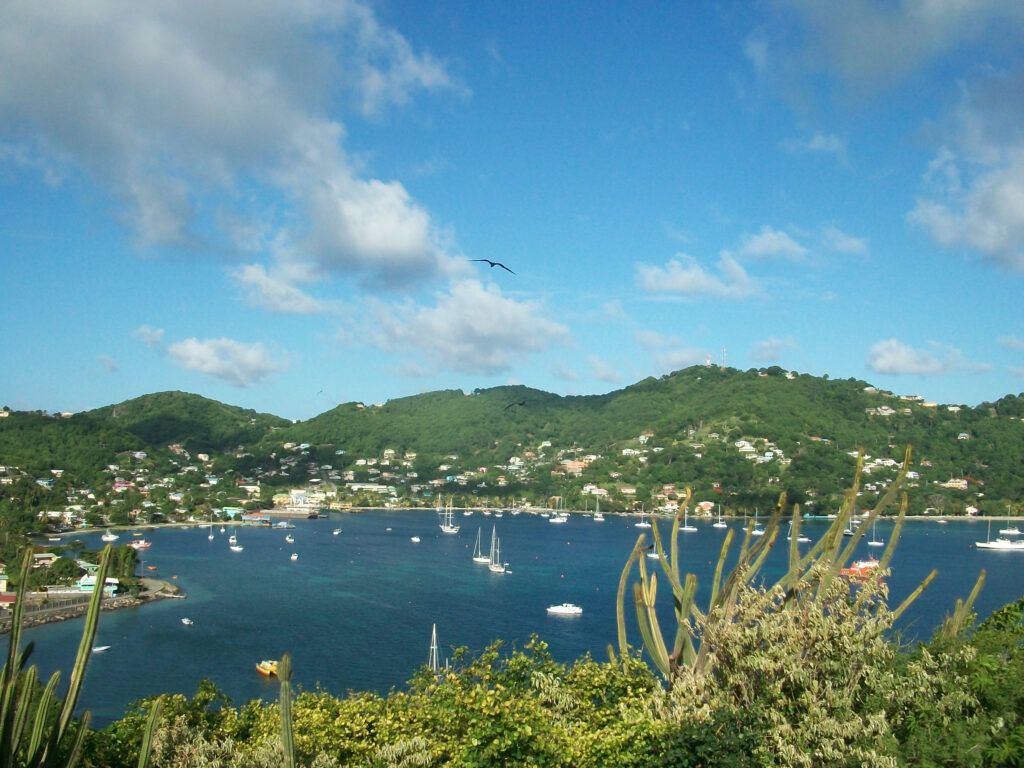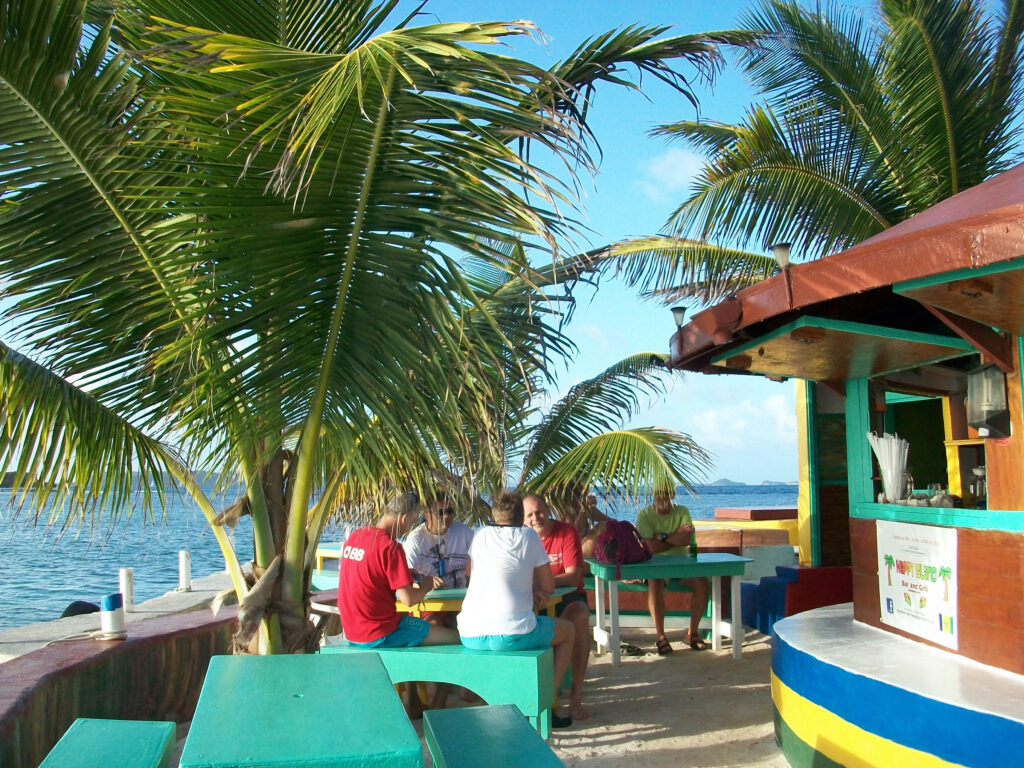I just can’t get enough. Every time I fly in, on a little twin-prop, gazing down at the blue paradise that is Tobago Cays, my heart skips a beat. The nervous anticipation of exhilarating sailing in the strong winds, and Atlantic swell, is calmed by the lee of a picture-perfect island sheltering a tropical beach and a rum shack!

What really makes the Grenadines stand out to me is how remote they feel. A far cry from the commercialization of the BVIs, the islands all have their own, different, authentic Caribbean characters. Scattered in a sparkling arc, stretching some 60nm from the southern tip of St. Vincent to Grenada, they are the perfect cruising area for the more experienced sailor. When I’m sailing there, I feel so far removed from the rest of the world, and that’s such a valuable feeling these days.
The peak season here runs from Christmas to Easter, when the fresh trade winds regularly top 20 knots and there is little rain. Come out of that season, and you can expect a bit more humidity, some rain and lighter winds. The main hurricane belt is north of the islands. Grenada is actually a popular summer base for many Caribbean cruisers, whose yacht insurance dictates they be south of 12 degrees latitude from June to November.

Sailing can be fresh in between the Windward Islands! The Atlantic swell is often over the bow, and one reef in the main is common. It’s an exciting area to stretch your skills and blow the cobwebs away. However, it’s reassuring to know that most passages between the islands only last a few hours, and then you’re out of the swell, tucked in behind your destination. The winds are mainly north east or east in the winter season, making trips north up the chain harder. A sensible tip is to start your charter in St. Vincent and finish in Grenada – a service most charter companies are happy to provide. This allows the majority of your island hopping to be on a southern bearing, on either a beam or a broad reach.

Navigation is, on the whole, easy between the islands, though it pays to keep an eye to windward for passing Atlantic squalls. They can approach quickly and winds can pick up before they hit. Once the rain has set in, it usually calms, and they pass as quickly as they arrived. The canny sailor can often put a tack in at the right time though, and watch the squall sail right past, before resuming their course. There’s no real tide to speak of, but the currents from the Atlantic can be hard to account for when plotting courses, it’s a bit of a black art to get it right! Happily, on the majority of passages your destination island will be within sight, with only the southernmost passage to Grenada being a bit further. This passage also takes you past a submerged volcano named Kick’em Jenny! There’s an exclusion zone here which you must avoid. Frighteningly, submarine gaseous eruptions can result in negative buoyancy!

Once close to the islands a little more diligence is required, reefs are common and several areas require clearing bearings. The swell and the stronger winds can make pilotage tricky at times. A crewed yacht can be a great way to relax and explore the islands, with a professional crew guiding you around the highlights. A great learning experience, and an amazing holiday!
Typically, mooring is on the anchor or a buoy, with a few marinas and quaysides to tie up to. Buoys are usually available, though Christmas and New Years can be busy. They cost from $50EC upwards a night (around £15). Most boat boys, who service the buoys, offer a reputable service. A good charter company will provide you with contacts in most harbours, so you can sleep well knowing you are attached the something solid! When anchoring check the pilot book first; it’s prohibited in some areas for reef conservation. When you do drop the hook, look for pale areas where the bottom is sandy. Holding is generally good in thick sand, and it should soon become clear that your biggest problem will be lighting the BBQ in 20kts of wind, not worrying about the boat dragging! A snubber can be a good idea, as a little swell, and overnight wind, can make for a noisy evening in the forepeak.

It’s very hard to pick a few highlights of the area. The Windward Islands cruising area is compact, but littered with gems and keeps on giving as you scratch deeper. It’s a water sports paradise really, with excellent diving, kite surfing and sailing.
Though it hurts me to say it, and believe me, I bleed salt water, if there was ever an area to take a crewed charter this might be it. There’s simply so much to see in a week or two, that you can miss the highlights in the time it takes to get accustomed to the sailing and the navigation. A professional crew also deal with the Caribbean hustle, leaving you to enjoy all the good stuff!

St. Vincent: Fort Duvernette
Fort Duvernette towers above Young Island on the south of St.Vincent, close to Blue Lagoon Marina where many Sail Grenadines charters start. The fort was built in 1790, and if there’s a location that just screams ‘Pirates of the Caribbean’ then this is it. Take a buoy in Young Island Cut outside the luxury resort where Johnny Depp stayed while filming. However, if you prefer to anchor, beware the current in the Cut shifts 180 degrees. Take the dinghy to the landing stage below the fort, and climb the stone steps that cling to the side of the rock, up to the gun emplacements at the top. Original cannon still sit in place, and the view of St. Vincent’s palm-fringed coast is spectacular.
Bequia: Moonhole and the Plantations
Bequia has a stunning harbour, Port Elizabeth, and is a popular destination for Christmas and New Year’s with a great party atmosphere. I was based here whilst working for Sail Grenadines, Sail Ionian’s sister company. There are plenty of solid mooring buoys, fuel and water barges, the Rastafarian fruit and veg market, many great restaurants and rum bars, all making it a great bolt-hole in case of bad weather. Moonhole is a bit of a curiosity just south of Port Elizabeth though. Built in the 1960s as an ecological settlement, the first house was constructed under a stone arch and was built of whale bones and driftwood. Other houses followed and the community now consists of some 20 dwellings, some of which are available to rent. It’s a crazy place to sail past. Bequia also has some gorgeous old plantations nestled in the lush interior. It’s easy to find a jeep tour, and take in the Heritage Museum, sugar plantations, visit Firefly plantation and participate in the nearby sea salt tour or tasting. Time ashore here is well spent, to soak up the culture and history of the area.
Tobago Cays Marine Park:
I wanted to focus on the lesser-known highlights of the area, but no visit to the Grenadines would be complete without spending some time in Tobago Cays. These five islets; Petit Rameau, Petit Bateau, Baradal, Petit Tabac and Jamesby, and the reef that surrounds them, are one of the most beautiful places I have ever been to. Scattered on the edge of the Atlantic, you can swim all day with turtles, watch the sun go down over the open ocean, and then dine on lobster at a local run beach BBQ shack. It feels as if you are on an atoll at the edge of the world, which, in a way, you are. On one week-long charter I skippered, the guests demanded we stayed… one night turned into five before they had had their fill! There are secure buoys in the main anchorage, run by the park rangers to preserve the coral. If you are lucky enough to charter a crewed catamaran with a shallow draft, a local crew will know where to moor in between the shallow reefs, and secure you idyllic isolation. The snorkelling and scuba diving here are out of this world.

Union Island: Chatham Bay
Union is the main port used to transit between the countries of St. Vincent and Grenada. The town of Clifton is a busy, buzzy place sheltered by the reef that surrounds the harbour. Most cruisers will stop here to get their passports stamped as they leave SVG, and if you do, do not miss taking the dinghy to Happy Island, an amazing reggae bar on the edge of the reef! However, on the west side of Union is the sheltered remote bay of Chatham. It’s a large, easy anchorage, and when I’m there I love to watch the uninterrupted sunset over the Caribbean Sea. This is one of the places where, if you’re lucky, you can see the legendary green flash as the sun sets. It’s an optical effect caused by sunlight refracting in the atmosphere, only visible when the conditions are right. A kilometre of fine sand hides a few BBQ shacks and a small, upmarket hotel bar. The lush vegetation behind the beach hides many hiking trails, and Union is a great island to explore. As an antidote to the bustle of Clifton, it makes a tranquil overnight stop.
Grenada: The Molinere Underwater Sculpture Park
Grenada, known as the Spice Island, has a wonderfully relaxed vibe. It’s a great place to extend your holiday with a villa or hotel stay as there is so much to do in the interior. Rainforest trekking, a tour of the chocolate factory, sugar plantations and rum distilleries are all great options if you stay on. Before returning the yacht though, anchor in Dragon Bay on the west coast just north of St. Georges. The waters off the southern headland hide over 60 sculptures on the sea bed. Created by British artist Jason deCaires Taylor in 2006, the sculptures are mostly human forms, modelled on local inhabitants. They vary in depth down to 12 meters, and if you scuba dive it’s worth arranging for a local dive company to pick you up from your yacht, otherwise you can snorkel above the figures.
I feel like I have missed so much, there are so many more places to see that you shouldn’t overlook though. There’s a brand-new luxury marina and resort on Canouan that should be mentioned. Mopion is an unforgettable tiny sand islet lapped by turquoise waters, with one beach umbrella to relax under. Horse riding at sunset down Macaroni Beach on the ultra-luxury private island of Mustique…
Maybe I’ll see you there, this winter.


